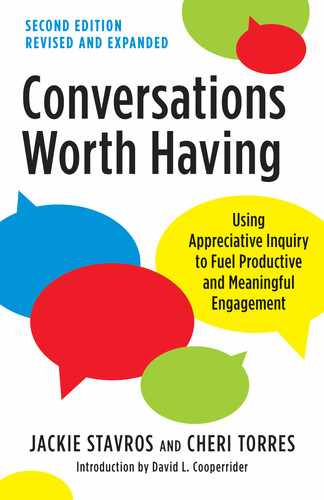3
Who’s Driving? Tune In

Knowing yourself is the beginning of all wisdom.
—Aristotle
In our work with clients and colleagues, we discovered that an important element was missing from our first edition. It became apparent that conversation is like the water in which fish swim, so omnipresent that we lose awareness that it is the medium in which we navigate our lives. Our conversations are fateful. What we think, say, and do influences every moment in our lives. When we converse without self-awareness, our conversations are channeled through our resting body-mindset. In other words, our current frame of mind, our dominant thoughts and feelings, and our current physical state drive the conversation.
Our resting body-mindset lies beneath the surface of present awareness. This means we are at the mercy of subconscious drivers such as judgment, assumptions, biases, and low blood sugar. To consciously step into the driver’s seat requires self-awareness and choice. It entails tuning in to what’s going on to make the subconscious conscious. With awareness, we can choose our words. We can decide how to respond, what to say and ask. In other words, we can intentionally foster conversations above the line. This chapter offers a technique for doing that.
First, let’s see how the resting body-mindset influences Jake’s and Timmy’s interactions. Jake hadn’t slept well in weeks, hadn’t touched his bottle of water all day, and had inhaled his lunch while working to meet looming deadlines. At 3:00 p.m., Sandy stuck her head in his office, smiled cheerfully, and asked, “Do you have those stats for me yet?” He snapped back at her with such fierceness, it took her breath away. She disappeared quickly. Jake sat stunned at the way he’d just treated his colleague, unleashing a cascade of self-loathing, blame, and shame. He left that day sure his colleague would tell others what a terrible team member he was. He was angered by that thought and felt she’d be right. Jake was having a most depreciative conversation with himself. He was definitely below the line.
Timmy said something embarrassing in front of his whole class, and all the kids had laughed at him. Even his teacher had smiled before moving on. He ran home after school. On his way to his room, his mom reminded him, “We have family photos in an hour. Please be ready.” “I’m not going,” he shouted as he slammed the door. His mom, who’d had a very long day at work, stormed after him, opened the door, and was ready to scold him until she saw his face. She stopped and took a deep breath. She felt her body relax and her demeanor soften. Then she asked with genuine concern, “What’s going on?” Timmy’s initial comeback to his mom’s reminder ignited what might have been a depreciative conversation. However, his mom recognized immediately he was below the line, and she intentionally shifted gears to the conversation worth having in that moment.
The difference between Jake and Timmy’s mom was that she’d tuned in to both Timmy and herself. Pausing and taking a deep breath gave her the space to intentionally change the trajectory of their interaction. Her ability to become aware of her body-mindset and her son’s was the difference between initiating a depreciative conversation and initiating one worth having.
Unseen Influences beneath the Surface
Our resting body-mindset is influenced by our past, present, and anticipated future. Our worldview, beliefs, assumptions, and biases have been formed as a result of past conversations and experiences. We begin taking in messages about how to make sense of the world the moment we are born. Cultural frameworks, norms, and biases mix with our interpretations of our experiences and the way we make meaning with others. These slip beneath the surface of awareness and influence our perceptions and subsequently our conversations. Our emotions and nervous system are influenced by the amount of sleep we get, the food we ingest, and the amounts of oxygen we take in and water we drink. And if that’s not enough going on beneath the surface, our nervous system is also influenced by other people’s state of being.1 If you’ve ever felt calm and content and then suddenly found yourself agitated moments after someone walked into the room—or the opposite, been anxious only to gain a sense of peace when another person entered—you’ve experienced this influence.
Like the iceberg that sank the Titanic, what lies beneath our surface often sinks our relationships and efforts (figure 3.1). When we are not aware that all these factors are influencing our conversations, they drive the interactions and often drive them below the line into the depreciative realm—just as they did for Jake and Timmy.

Until you make the unconscious conscious, it will direct your life and you will call it fate.
—C.G. Jung

Figure 3.1 Tip of Conversations
Unseen factors influence our conversations. When you are aware of them, you are better able to foster conversations above the line.
Jake was clearly stressed about work at the outset. On top of that, he hadn’t slept well, he was dehydrated, and it was midafternoon. He likely wanted to meet the needs of his teammates and worked hard to do good work on time. This was the perfect storm for a below-the-line conversation. Timmy very likely experienced an immediate threat response to being laughed at in school. Our need to belong is one of the strongest drives we have; it can be more important than food or shelter for some. Timmy was clearly below the line and set to collide with his mom’s stressed body-mindset. This could have driven a below-the-line conversation if they’d both remained unaware. Fortunately for Timmy, his mother tuned in to his inner state and then her own.
Location, Location, Location
When our conversations are below the line (depreciative), they generate stress, negative emotions and actions, and disconnection (refer to figure 2.2). Similarly, when our body-mindset is below the line (we’re experiencing stress, negative emotions, and disconnection), we tend to foster depreciative conversations. If we don’t tune in and become aware, we can end up in a downward spiral that tears at the fabric of relationships and inhibits our capacity for well-being and success. Recall Alisha’s experience from chapter 1. Month after month, she spiraled below the line.
Conversely, when our conversations are above the line (appreciative), they generate connection, creativity, productivity, learning, and engagement. And when our body-mindset is above the line (we’re feeling connected, creative, and engaged), we tend to foster appreciative conversations. One key to intentionally fostering conversations worth having is to know where you are: above the line or below the line.
Due to all the factors discussed above, in each moment of our lives, our resting body-mindset is primed for either above-the-line or below-the-line conversations. When we are below the line, we are primed to be defensive, closed, and committed to being right. This is the location of the fixed mindset.2 It is where we are driven by fear and scarcity as well as being dehydrated, undernourished, and tired. Here, life can feel overwhelming, hopeless, and unmanageable. We typically feel the need to protect ourselves to survive. Jake and Timmy were below the line, experiencing blame, shame, and negative projections (on themselves and others).
When we are above the line, it is easier for us to connect with others, to feel empathy and relate. Above the line, things seem possible in life; creative solutions emerge because we are curious and open. We often shift from “me” to “we” in the focus of our interactions, which makes it easier to listen to other points of view, broadening our perspective. Above the line, we naturally have appreciative conversations.3
Where are you in this moment? Are you above the line, open and curious about whether this idea applies to you? Or are you below the line, closed and dismissive? How do you know where you are? We’d like to offer you a simple strategy to increase your understanding of where you are. We encourage you to tune in.
Tune In
Locating yourself means tuning in to your body-mindset. The technique we use to tune in is this: pause, breathe, and get curious. Pausing stops the current momentum. Breathing deeply stimulates the parasympathetic nervous system, calming your stress response. To maximize the relaxation response, take a deep breath and hold it briefly. Then, exhale slowly, longer than your inhale. Then take another breath. This gives you a moment to expand your awareness, to observe yourself in the moment. Doing just this has the potential to move you from protect to connect. Why? According to Andrew Huberman, “The reason a breath practice is so powerful is that it’s a bridge between our unconscious, reflexive states and our conscious, deliberate state.”4
Try This Exercise from Huberman
“When you inhale, realize that you are literally taking control of your brain and mind; and when you exhale, allow that ability to take hold in positive ways. Intentional breathing reminds us that we are in control of our inner state at the most fundamental level. And you can grab ahold of that sense of control anytime stress hits or when you simply want to appreciate a moment and be more present.”5
After breathing, get curious. This further increases your awareness, allowing you to consciously choose to be in the driver’s seat: “Where am I? Where are others? What’s the bigger picture or context?” Such questions challenge our thinking and invite us to choose positive intention.
In this space between stimulus and response lies our opportunity to choose.6 What kind of conversation do I want to foster? What needs to happen in this moment to support that? It’s also an opportunity to explore what lies beneath the surface, influencing our present reaction:
• What’s this conversation really about?
• What assumptions am I making?
• What beliefs and preconceived ideas are influencing my perception?
• What else might explain what’s happening?
• Am I hungry? Thirsty? Tired? Hot or cold?
• What emotions am I experiencing, and what are they telling me?
• What don’t I know that might be important in this moment?
• What’s driving the other person’s behavior and actions?
• What do I want to have happen; what’s my agenda?
Here’s a simple example that may sound familiar. Becky has a habit of sharing her opinion without being asked, especially with her husband. After attending a Conversation Bootcamp,7 she realized her comments were often unconsciously driven and damaging to the person she loved. She was determined to start tuning in before offering her opinion.
Her first success in doing this came one morning while she and her husband were walking their dog. Her husband was sharing a story about advice he’d given someone he was mentoring. She felt her critic wake up, but instead of telling him why that advice was wrong, she paused and took a deep breath, giving her a moment to get curious. It took no more than a few seconds for her to ask herself, “How is my opinion relevant?” She thought, “He’s sharing a story about something that’s already happened. My opinion is irrelevant and off topic. What would deepen my understanding of the story?” Then she asked out loud, “Why did you give him that advice?” His response surprised her. With this added information, his advice seemed spot on. (Imagine that!)
Tuning in gives us the opportunity to choose to intentionally foster a conversation worth having instead of unconsciously reacting from beneath the surface. When we are tuned in and stay tuned in to the world within and around us, we are in the driver’s seat of our conversations. This supports our ability to intentionally foster and maintain conversations worth having, even if they become confrontational. Our ability to listen deeply while engaging in conversation is an important aspect of tuning in and staying tuned in.
Listening: The Silent Partner in Conversations Worth Having
Tuning in requires us to listen deeply to our inner state and to others. Asking who’s in the driver’s seat applies to listening as well as speaking. When we just listen without an intention to listen deeply, what we hear is filtered and scripted by those drivers beneath our radar (figure 3.1). This means we are at risk of listening with a closed mind, a closed heart, and a closed will. Our preconceived ideas, beliefs, and motivations may have us listening to find fault, judge, negate the other, or defend our point of view. This works well in a debate, but not if we want to have a conversation worth having.
Being intentional about listening takes practice. It means listening with an open mind, willing to entertain another’s ideas; listening with an open heart, willing to empathize with another person’s experience and understand a situation from his or her point of view; and listening with an openness to new possibilities and new ways of going forward. The Chinese symbol for the verb “to listen” captures the essence of what it means to listen deeply. The complex character is a combination of the characters for eyes, ears, heart, and undivided attention (see figure 3.2).
In preparation for listening deeply, you can do a quick one-minute emotional audit: “What am I thinking? What am I feeling? What do I want to happen now? What am I going to do next?” Then choose to be present: pause, take a deep breath, center yourself, relax, and invite just a little more ________ (e.g., space, openness, light, compassion, curiosity, interest).
When we are aware and able to choose to foster conversations worth having, listening deeply comes more naturally. Our questions are authentic. We are genuinely curious about the other person, interested in learning and understanding that person’s ideas and experiences, so we listen with an open mind and heart. We are interested in finding ways to achieve optimal outcomes, so we listen willing to entertain new ideas and possibilities. Engaging in such conversations comes down to our capacity to be intentional, to be in the driver’s seat.
Coming out of the Tunnel
When we are not in the driver’s seat, it’s like driving in a tunnel. We can’t see, hear, or understand anything beyond our biases, mindset, beliefs, and needs, which reflexively steer and sometimes recklessly drive the interaction. When we choose to step into the driver’s seat with awareness, we emerge from the tunnel. The horizon opens up. We see ourselves in relation to others and to the situation. We discover opportunities to see from another’s point of view, expand our world of possibilities, and find shared pathways forward. From this vantage point we can effectively use two simple practices to foster conversations worth having: generative questions and positive framing. In the next chapter, you’ll learn about these practices and how others are using them to intentionally strengthen their relationships, improve well-being, and generate success in their organizations.

Figure 3.2 The Chinese Character for “to Listen”

